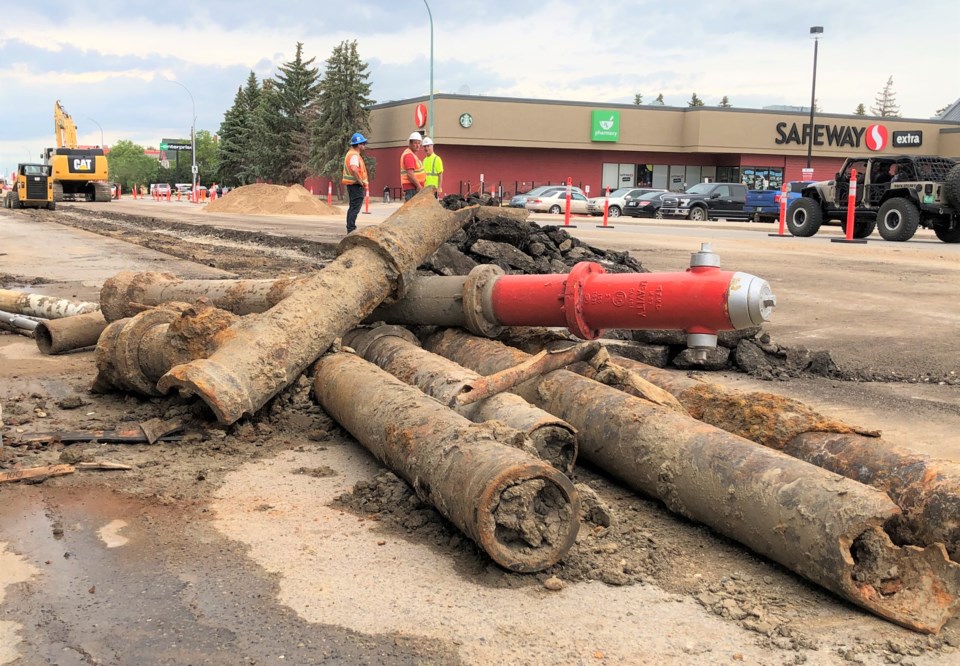Some city councillors are concerned that city administration wants to reduce the amount of cast iron pipe replaced in 2023 in favour of replacing more feeder mains and a wastewater lift station.
Next year, city hall wants to replace 2,800 metres of feeder mains for $3.5 million simultaneously with 2,100 metres of cast iron pipes for $4.6 million.
In comparison, the municipality replaced 3,470 metres of cast iron pipe this year for $7.1 million and spent $300,000 to replace feeders.
Feeder main projects
A feeder main is connected to a water main every few blocks and is part of the same network that moves potable water throughout the community, explained Bevan Harlton, director of engineering, during city council’s 2023 budget meeting on Nov. 30.
His department plans to focus on addressing the feeder mains on 16th Avenue West and Coteau Street, he continued.
The 16th Avenue feeder mains used to service a reservoir — which no longer exists — so many old large-diameter pipes move water slowly through that area. The goal is to replace that 350-millimetre (14-inch) pipe with a 254-millimetre (10-inch) pipe.
That project will occur from 2023 to 2024, with the city planning to spend $3 million in the second year.
The second project will replace the Coteau Street feeder mains on South Hill from 12th Avenue Southwest — there is a reservoir there — to First Avenue Southeast between 2025 and 2027.
“Holy smokes!” exclaimed Coun. Crystal Froese in response to the project’s 14-block replacement plan. “And you’re expecting to finish that in a season?”
City hall must finish the 16th Avenue project because the budget can’t support overlapping initiatives, said Harlton. The 16th Avenue project alone will replace 1,350 metres; it has a “bizarre alignment” that runs from Pascoe Drive to another crescent “and is in a strange spot” that included a former reservoir.
Cast iron projects
The reason the cast iron budget has declined because the Crescent View lift station needs replacing, Harlton explained. Furthermore, he has a small design team that focused heavily on cast iron for the past three years and must catch up on recording keeping.
The team has less time to plan for the cast iron program because it is focusing on the required size of feeder main pipes, which is a more significant component for a new lift station, he added.
Council concerns
The reduced focus on replacing cast iron pipe is concerning because it was a difficult project even to start, and for those current councillors around during those talks, there was “a lot of blood, sweat and tears” shed to ensure it began, said Coun. Heather Eby.
The project even cost some councillors their seats for defending the program, she continued.
Eby’s perpetual worry is that when new faces join council, those people will forget how hard the previous group worked to institute the program and provide funding. They could see the program as “low-hanging fruit” from which to take money for other things — and it would eventually vanish.
“I’m very cautious about robbing Peter to pay Paul,” she said.
Eby also thought that reducing the amount of cast iron replaced would extend the program to 30 years instead of 20 years.
Coun. Dawn Luhning agreed, saying the community made replacing cast iron a priority. Moreover, council must continue to focus on that even when there are other needs.
“I get that Crescent View needs to be completed, but I don’t think we can sacrifice the cast iron project to say we need to move to Crescent View … ,” Luhning continued. “If we back off, there will be more breaks on cast iron. … We just need to be very, very careful in backing off.”
Tired residents
The idea of whether 84 kilometres of cast iron could be replaced over 20 years was answered affirmatively this year when crews “went full tilt” and replaced nearly 3.5 kilometres of cast iron, Harlton said.
However, replacing four kilometres yearly is “just past” what Moose Jaw can handle, especially since plenty of pipe downtown needs replacing — and none was replaced this year.
A third crew and two separate contracts would be required to replace more pipe, while city hall would have to lock down the community in construction “ever so slightly more,” Harlton added. Many residents this year asked when the city would back off on construction because they were tired of it.
Eby appreciated Harlton’s observations, noting while the work is being done, people can tolerate only so much disruption.
Froese agreed, noting the sound of trucks reversing grates on people’s nerves. It didn’t bother her after the city completed work in her area, but a nearby neighbour who worked nights and slept days had issues.
“Cast iron is great, but if feeders are breaking, then you’re obviously not going to get water to people … ,” she added, “so we can’t have one without the other.”
Luhning also understood residents’ fatigue but pointed out that one project this year was supposed to be eight weeks long and took all summer because — some days — construction crews didn’t work. Her solution was to have crews work around the clock — especially in good weather — to finish projects.
The next budget meeting is Monday, Dec. 5.



